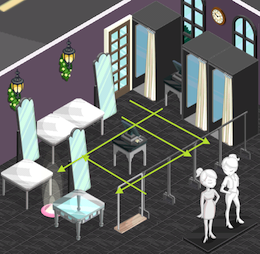Table of Contents
Definitions
Fashion Story is an iOS game, comparable to the SIMs in which you have to build your shop, order items and then sell them. Making money is relatively easy if you consider the following observations:
- All shoppers are automated and not real people.
- Shoppers walk in your shop from tile to tile.
- Two shoppers can occupy the same tile at the same time.
- A clothing rack needs a changing booth.
- A table needs a mirror.
- Every clothing rack or table can stack up to
 units (clothing confirmed, table unknown assumed the same).
units (clothing confirmed, table unknown assumed the same). - The more expensive the clothes you order, the greater the payoff.
- Every clothing type has a gauge, and when ordering the same clothes over and over again, we get a diamond.
- The more income a clothing type or jewelry generates, the longer it takes to deliver.
- Unless a requirement is missing (mirror, changing booth), a shopper will always buy something.
Generally, in order to squeeze out the most profit, we design a rat-maze where we hinder the movement of the shoppers so that they are coerced to move constrained by objects. We also keep in mind that the distance to travel from the entrance to the farthest corner of the shop should be minimized because those items will be less likely to be bought (ie: a shopper will spot an item they like, more likely, before reaching the end of the shop).
Tactics
To start off, consider the following bird-eye view arrangement of a shop:
This arrangement is purposefully cramped leaving only two blank tiles for shoppers.
Derivations
- Since two shoppers may occupy the same tile at the same time (
 ), the arrangement does hinder any movement of the shoppers or shopping.
), the arrangement does hinder any movement of the shoppers or shopping. - Since a table requires a mirror (
 ), we have a table
), we have a table Tand a mirrorM. - Since a clothing rack requires a changing booth (
 ), we have a clothing rack
), we have a clothing rack Cand a changing boothB. - Because each table and clothing can stack up to
 units (
units ( ) and since the more expensive the clothes, the greater the payoff (
) and since the more expensive the clothes, the greater the payoff ( ), we keep ordering the most expensive clothes and shoes and stack them on the table, respectively clothing rack.
), we keep ordering the most expensive clothes and shoes and stack them on the table, respectively clothing rack. - Since we get a diamond by exhausting a clothes and shoes (
 ), we order the most expensive items over and over again in order to get diamonds.
), we order the most expensive items over and over again in order to get diamonds.
Picking Expensive Items
Here is an overview of the pop-up when ordering items:
+---------------------------------+ | +------------+ +------------+ | | | | | | | | | | | | | | | DRESS | | SHOES | | | | | | | | | +------------+ +------------+ | | +------------+ +------------+ | | | | | | | | | | | | | | | JEWELRY | | JEWELRY | | | | | | | | | +------------+ +------------+ | +---------------------------------+
The most expensive item is usually the dress on the top-left and the next up are the shoes on the top-right. The other two on the bottom, the jewelry items serve no purpose in this model and should not be ordered because they do not generate any competitive income compared to the dress and the shoes.
The items that bring the most income are the ones that take the most time to deliver ( ) however, it seems that items with lower delivery times do not bring a comparable income (unconfirmed, observational).
) however, it seems that items with lower delivery times do not bring a comparable income (unconfirmed, observational).
Blockers
Any item that cannot hold merchandise, nor is a requirement for a certain type of merchandise to be bought, is considered a blocker (ie: decoration). They do not generate money but may be used to block the path of shoppers. Good examples included vases, sculptures, newsstands and lights. Purchasing them does not lead to any gain but they can be used as blockers.
Upkeeep
Another goal is to reduce the shop size so you can keep all the racks full at all times. This is rather tricky because low stock items on clothing racks and tables are due to expire quite fast.
In order to avoid this, ideally one would order very expensive items that take long times to deliver ( ) and keep ordering them until the racks and tables they are placed on are full. When that happens, one can reserve two order slots and buy restock material and use the other free slots to purchase a new merchandise type.
) and keep ordering them until the racks and tables they are placed on are full. When that happens, one can reserve two order slots and buy restock material and use the other free slots to purchase a new merchandise type.
Examples
This example is one such build that follows the guidelines mentioned in this article. The accessible routes for the shoppers are marked with green arrows. As you may observe, the shop is built so that the shoppers are free to move on one single tile route, leaving them with backward and forward as the only possible routes ( ). The cashiers are placed at the exit and between the racks, the middle one functioning as a blocker. The clothes are either dresses or shoes, with an exception being the handbags that qualified as the next item with most income.
). The cashiers are placed at the exit and between the racks, the middle one functioning as a blocker. The clothes are either dresses or shoes, with an exception being the handbags that qualified as the next item with most income.
The two tables against the western wall, along with the mirrors are also strategically placed. Shoppers seem to immediately stop at the first table or clothing rack. The mirror is thus placed next to the entrance in order to increase the traffic to other racks and tables as well.
This build generates lots of money and requires little intervention or upkeep. It may be one way to take the fun out of the game, but would you have preferred a crack?
Deviation from Fashion Story

One would think that some "high fashion" shops are poorly designed because they are too cramped. However, it seems that the same rat-maze technique is indeed applied by shopkeepers in real-world shops. The reasoning is that by creating a rat-maze and not allowing people to move at large in shops, the maze reduces the distance required to travel between racks or stands.
This applies even if in the real world, two shoppers cannot occupy the same spot at the same time - and probably linked to the competition where by making people brush against each other, you increase their will to attain their goal (by raising the difficulty to attain it).
- Shops should build a maze, people thinking that they are "random" are rather misguided. People love patterns and once they see one they are prone to adopt them and repeat them (one example being music). Thus shops should build a labyrinth rather than placing the items in plain sight.
- Crowded shops also seem more prosperous than empty shops. If the shop is cramped then it gives the allure of being a sought-after shop. Otherwise, if everything is in plain sight, it makes the shop look small and unpopular.
- Expensive or eye-catching items should be placed near the end of the shop since the reward is greater if a shopper travels a longer distance to reach them. This may be counter-intuitive but it plays on the hoarding behavior of shoppers: nobody is going to buy something that everybody else can find so easily. Items that are placed next to the entrance of the shop, barely receive any attention and are most commonly occupied by consumables.
- Cashiers should be placed strategically so that they are easily accessible by shoppers. They should also be placed near the entrance of the shop (or as close as possible) because a shoppers that have already paid, will most likely not pay again so the goal is dispose of them as fast as possible. It is unlikely that a shopper will buy something and then go back and repeat again and if they do, then it is inefficient for the traffic flow because that shopper occupies space for new potential shoppers.
For the contact, copyright, license, warranty and privacy terms for the usage of this website please see the contact, license, privacy, copyright.




